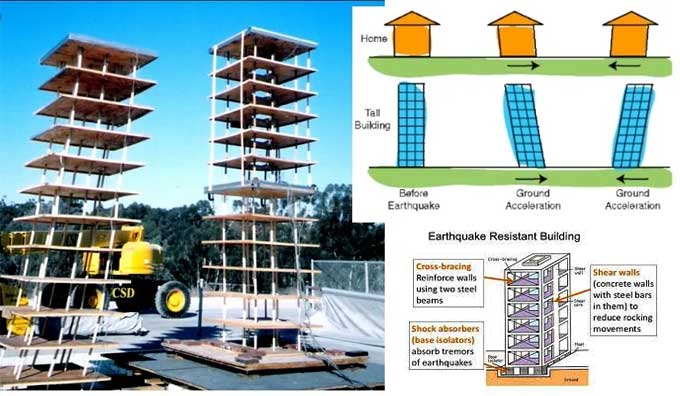
Earthquake-Resistant Building: Detailed Guide

As we all know, one cannot defeat the forces of nature completely, but with the help of engineering, one can make some progress in overcoming those forces to some extent.
Infrastructures are most likely to be damaged in the event of natural disasters such as earthquakes, floods, etc. because infrastructures are exposed to the most damage. A structure that is designed carefully and considers potential problems in the future and in the present must be able to prevent these catastrophes from occurring.
Buildings that are earthquake-resistant should first be educated about earthquakes and their causes of them.
Earthquake-related reasons for building failure
Soil deformation
When an earthquake occurs, it can create a force that is powerful enough to turn soft soil into quicksand, which in turn will prevent the soil from bearing the weight of the building.
Foundation issue
Although buildings can support loads of their own, they are not designed to withstand irregular, multidirectional, and intense side-to-side loads that occur during earthquakes, and this can cause structures to crumble.
Joints issue
An earthquake may result in structural collapse when the structures do not have adequate clearance between them, and when structural joints are not allowed to bend.
Design failure
When a structure is not designed to be highly ductile and capable of resisting seismic waves, it can cause disaster in case of an earthquake.
Methods to build earthquake resistant structure
Here are a few methods to build earthquake-resistant structures:-
A proper durable foundation
The most crucial part of any construction is the foundation since it supports the weight of the structure. However, not every project can use the same sort of foundation; therefore each one must be specially constructed.
When designing the structures that can withstand earthquakes the structure must be built on top of pads that are often composed of steel, rubber, and lead.
It keeps seismic waves from passing through the building and isolates it from the ground. Therefore, only the pads move during an earthquake, keeping the building stable.
Utilizing the Seismic dampers
Building constructions employ seismic dampers to control the building's vibrations during an earthquake.
Although there are many other types of dampers available for a building, friction is the most effective means of dispersing kinetic energy. These dampers enable the building to move elastically and disperse seismic energy.
Installing the devices for vibration control
Different structural designs have shown that vibrational control devices are most effective in seismic hazard reduction strategies. The common use of these vibrational control devices is energy absorption.
In order to resist seismic and wind waves, these devices are often used in mid- and high-rise structures as an energy-absorbing system.
Cross bracing installation
When cross bracing is used to reinforce building structures where diagonal supports join, it can assist in the construction of earthquake-resistant buildings.
Bridges with two diagonal supports arranged in an X pattern frequently include cross-bracing. This bracing will support lateral pressures during an earthquake, including seismic or wind waves, and while one brace is under strain, the other will be compressed.
Diaphragm install
A diaphragm is essentially a floor or roof that transmits the building's lateral stresses to the vertical parts. Additionally, a diaphragm connects vertical pieces, stabilizes them, and transfers stresses between them as needed during an earthquake's shaking.
To learn more, watch the following video tutorial.
Video Source: Interesting Engineering
In order to construct an earthquake-resistant building, diaphragms are a crucial component, and the seismic force-resisting system must be taken into account while constructing the building components.
Utilization of Shear wall
Shear walls are structural members mainly used in RC-framed structures to resist lateral forces such as wind and seismic forces.
For tall buildings, it is a good option to use shear walls, and they provide stability for the members to create a rigid, moment-resisting frame. As said earlier shear walls help to resist seismic forces in high-rise buildings, it should be considered to build earthquake-resistant buildings.
Earthquake-resistant materials should be used
Building materials are crucial in the construction of structures that are resistant to earthquakes; the lower the quality, the more susceptible the building is to an earthquake.
The materials must be very ductile and able to withstand significant deformation and stress. Some materials, such as steel and wood, are extremely ductile and earthquake-resistant. Therefore, it is advised to utilize only tried-and-true materials.
With the advancement of engineering technology, a variety of construction materials have been created that retain their form better than ordinary materials. One such material is memory alloy, which can withstand significant stress and return to its original shape.
Build a plan with expertise in such fields
Creating earthquake-resistant buildings requires the expertise of professionals, so look for professionals with a proven track record of success.
During the design process, it is very important to pay close attention to ductility and the capacity of the building to withstand an earthquake without collapsing. A number of experts agree that a structure's ductility can be increased by evenly distributing mass and strength throughout the structure.


